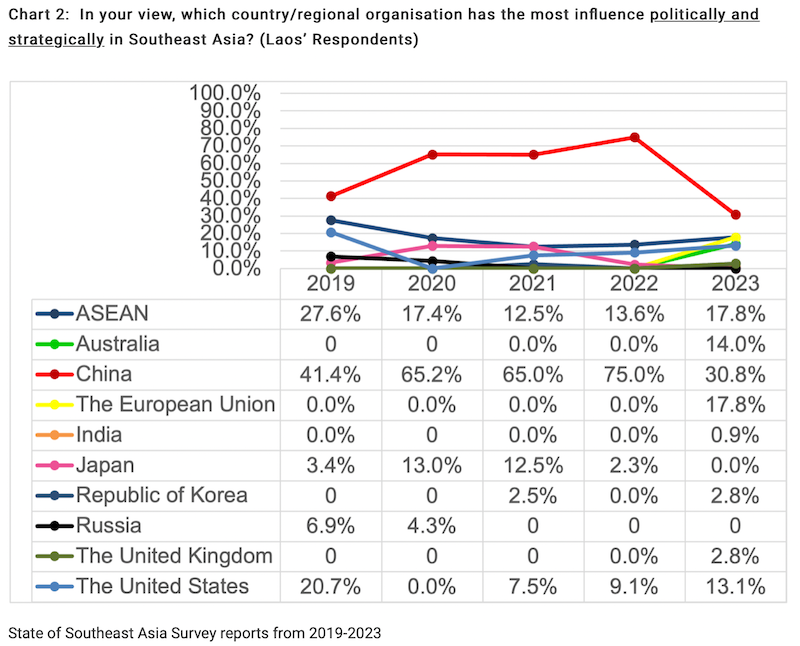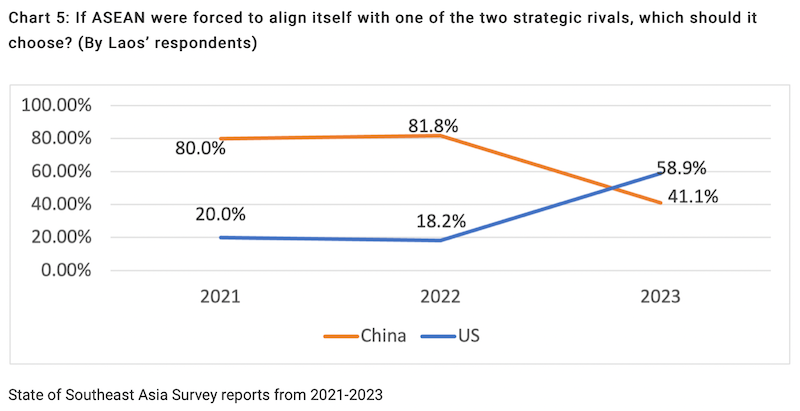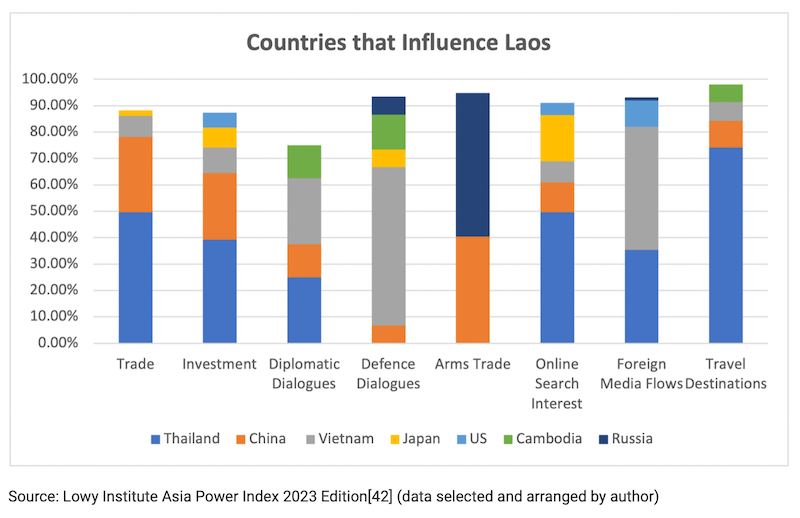Changing Perceptions In Laos Toward China – Analysis
INTRODUCTION
Since the revival of its influence in Southeast Asia in the early 1990s,[1] China has become an important economic investor and development partner for the region, especially for Laos and Cambodia.[2] China has retained its position as ASEAN’s largest trading partner[3] since 2009, and ASEAN has become China’s largest trading partner since 2021.[4] For Cambodia and Laos, China constitutes the largest source of foreign direct investment outside of ASEAN.[5] As such, China has been viewed as the most influential economic power in Southeast Asia, according to recent State of Southeast Asia Survey reports.[6]
Due to Laos’ limited developmental options,[7] it has benefited significantly from China’s investment. This is particularly through the Belt and Road Initiative (BRI) which is perceived to help regional countries achieve faster development.[8]
The scale of China’s investment in Laos, especially in infrastructure such as the China-Laos railway, hydropower dams, and special economic zones (SEZ), has resulted in an increase in China’s influence in both tangible and intangible ways.[9] The growing dependence of Laos on China has led academics and media to sometimes frame Laos as a “vassal” or “satellite” state to China, unable to think and act independently.
However, a closer examination of Laos’ foreign policy, political priorities, and trade (away from the lenses of major power rivalries) reveals that Laos can be “even-handed” or independent when it comes to international relations, and is able to strike a balance between its neighbours (particularly Vietnam and Thailand) and other major powers.[10] There are also indications that Laos has sought to diversify its foreign relationships (including in development assistance) beyond China.
The State of Southeast Asia 2023 Survey Report [11] has shown that China’s influence in Laos may be significant but it is nevertheless slowly waning. An increasingly assertive China and the deepening of US-China rivalry have placed greater pressure upon Laos to move towards neutrality and to increase its reliance on ASEAN member states, or middle powers such as the European Union (EU), Australia, Japan, and South Korea.
The Lowy Institute Asia Power Index[12] has also indicated that China’s influence on Laos is not the greatest where trade, investment, diplomacy, media (and social media), defence, and even UN voting alignments are concerned.
This Perspective will examine the changing perception of Laotians about China, and how Laos is more neutral than media reports and academic analyses generally claim.
THE STATE OF SOUTHEAST ASIA SURVEY FINDINGS[13]
(Note: The survey’s methodology has not changed across the four to five years of analysis. Starting in 2022, the survey was conducted both online and offline (CAPI method) in order to reach more respondents. The CAPI method for Laos started in 2023. The number of Laos respondents increased from 43 in 2022 to 107 in 2023. In terms of affiliation, Laos respondents from across four categories namely the academic/think-tanks/research institutions; the business/finance sector; civil society/NGOs/media; and the regional /internationals have increased in 2023 as compared to 2022, while respondents from the government sector decreased[14] in the same period.)
Major Powers’ Economic, Political and Strategic Influence in Laos
A five-year analysis of the State of Southeast Asia Survey reports from 2019 to 2023 shows that while China continues to enjoy a certain degree of influence in Laos, its economic power has been perceived to be declining, with the exception of 2020-2021 (Chart 1). The most significant decline was recorded for 2022-2023; China’s economic influence in Laos plunged from 86.4% to 20.6% (Chart 1), while China’s political-strategic influence in Laos decreased from 75% to 30.8% in the same period (Chart 2).
A growing number of Laos’ respondents have also indicated worry about China’s growing economic influence (an increase from 65.8% to 72.7%) while an increasing number of respondents welcome the US’ growing economic influence (from 0% to 50%) from 2022-2023.
In the same period, ASEAN’s economic influence among Laos respondents increased from 2.3% to 29.9%; Australia’s influence increased from 0% to 16.8%; and the EU’s influence increased from 6.8% to 16.8%. Japan, South Korea, the UK, and the US all registered an increase in economic influence among Laos respondents.
Similarly, Australia (0 – 14%) and the EU (0 – 17.8%) recorded the largest increase in political and strategic influence, while ASEAN, India, South Korea, the UK, and the US registered a smaller degree of increase among Laos’ respondents in the period 2022-2023.


Laos’ Perceptions of Major Power Leadership
A four-year analysis has shown that Laos’ respondents generally favour China with regards to leadership in championing global free trade (Chart 3). However, while China’s popularity soared in the period 2021-2022, it plunged from 61.4% in 2022 to only 14% in 2023 (lower than ASEAN’s and the EU’s). On the flip side, confidence in ASEAN increased from 6.8% to 26.2%; Australia from 0 to 10.3%; and the EU from 6.8% to 25.2%. Perceptions about the US have remained rather constant in the last three years (between 14% and 15.9%).
With regard to leadership in maintaining the rules-based order and upholding international law, Laos’ respondents’ confidence in China has consistently decreased over the past four years from 26.1% in 2020 to 5.6% in 2023 (Chart 4). In the period 2022-2023, the EU became Laos’ top option at 29%, an increase from 13.6% in 2022, while confidence in Australia increased from 0% to 17.8% following Russia’s invasion of Ukraine. Greater confidence is also recorded for New Zealand and the UK. China’s “no-limit” partnership with Russia, along with ASEAN countries’ (including Vietnam) concern about China’s more aggressive stance in the South China Sea may have contributed to the declining confidence.


Impact of China-US Rivalry on Laos
If ASEAN were to align itself with one of the two strategic rivals (the US or China), an overwhelming majority of Laos respondents, from 2020-2022, chose China over the US (Chart 5). However, in 2023, 58.1% of respondents chose the US, while only 41.1% of respondents chose China.
In the survey done in 2023, when asked about seeking out “third parties” to hedge against the uncertainties of the US-China strategic rivalry, the biggest group of Laos’ respondents (42.1%) chose the EU while Japan (18.7%) and Australia (16.8%) were in the second and third places respectively.

Summary of Findings
The findings have revealed that while China continues to have some degree of influence over Laos politically and economically, its influence has declined, particularly between 2022 and 2023. Confidence in China as a global leader to promote free trade or to uphold a rules-based order has also declined among Laos’ respondents. China’s COVID restrictions on borders and suspension of Laos’ exports have affected Laos’ businesses and farmers.[15] As such, there is a growing sentiment in the preference among respondents for middle powers, particularly the EU and Australia, to play a greater leadership role. Confidence in ASEAN has also increased with regard to its economic role in the region following the entry into force of the Regional Comprehensive Economic Partnership (RCEP) in January 2022 and the diversification of production sites from China to Southeast Asia as a result of the intensifying US-China rivalry. Economic growth in neighbouring countries including Thailand and Vietnam has resulted in an increase in their trade and investment with Laos.[16]
In the 2023 survey, when asked what could potentially worsen Laos respondents’ positive impression of China, the majority chose “China’s interference in my country’s domestic affairs (including influence over the ethnic Chinese citizens of my country)” at 56.7% and “China’s use of economic tools and tourism to punish my country’s foreign policy choices” (43.3%). This demonstrates that the growing presence of China in Laos may inevitably lead to concerns over domestic interference.
Apart from the trends in major powers’ influence and rivalry, Laos’ respondents have generally displayed neutrality (significantly above the regional average) in their outlook toward regional and international developments. This includes indicating the “neutral”, “not sure” or “no comment” options in questions relating to the Myanmar crisis, tensions in the Taiwan Strait, the Quadrilateral Security Dialogue (QUAD), the Indo-Pacific Economic Framework for Prosperity (IPEF), and China’s Global Security Initiative (GSI). This could possibly indicate a passive or neutral stance of Laotians toward global developments or a preoccupation with economic developments rather than political-strategic affairs.
LAOS’ MIXED VIEWS OF CHINA
It is without doubt that trade and investment relations between Laos and China have been growing. The two-way trade volume between the two countries was estimated to be US$4.15 billion in 2021, and increasing by approximately 20% yearly.[17] China accounts for more than 80% of Laos’ agricultural exports,[18] resulting in a trade surplus for Laos. China is also the main source of infrastructure financing in Laos. There are at least 815 projects funded by China (mostly under the BRI) to an amount of over US$16 billion since 1989.[19]
Among China’s infrastructure investments in Laos, the China-Laos railway is one of the most significant and controversial projects, considering its hefty price tag of US$6 billion.[20],[21] As a result of Laos’ significant reliance on China’s infrastructure financing, its total debt exposure to China (the largest single bilateral lender) is estimated to be approximately US$12.2 billion or 64.8% of its GDP,[22] resulting in some observers accusing China of ‘debt trap’ diplomacy.
In the past two years, rising debt is further exacerbated by the impact of the COVID-19 pandemic, inflation, and the rapid depreciation of the local currency the Lao Kip (more than 45% against the US dollar) making Laos’ debt repayment more expensive and putting the country at risk of defaulting. As a result, the public has expressed concerns[23] for fear that its sovereignty could be implicated in the case of compromising lands or national assets for debt repayment.
However, despite the growing debt, these infrastructure loans are generally viewed as necessary to expedite Laos’ economic development and trade. The China-Laos railway for example could be Laos’ best bet to boost its connectivity to turn its unfavourable land-locked status into a land-linked status with the second largest economy in the world. It is expected to boost the country’s GDP by US$81.63 million[24] (cost of freight to reduce by more than 30%) and tourism from China by at least 20%.[25] Apart from enhancing its connectivity with China, the railway with its ‘dry port’ is expected to be linked to the Greater Mekong Subregion[26] so that Laos can be an important logistics hub within continental Southeast Asia. This will not just boost its economic performance but also increase the people’s confidence in the Lao People’s Revolutionary Party.[27]
Another controversial development in Laos is the growing number of hydropower dams[28] built under the BRI which have the potential to turn Laos into the “battery of Southeast Asia”. While sustainable energy is sought after by the region, there are concerns over safety,[29] environmental damage[30] and livelihoods, including the potential effects on downstream states (Cambodia, Thailand and Vietnam), as well as worries about China’s increasing control over Laos’ energy resources. The China Southern Power Grid Company has a majority share under the Électricité du Laos Transmission Company Ltd and can effectively control the electricity export of Laos under a 25-year concession agreement.[31] Other concerns include the erosion of Laos’ social fabric due to these developments as well as local businesses being taken over by Chinese nationals who are not able to converse in the Laotian language.[32]
As such, while there are clear economic benefits brought about by China, there are also rising concerns and pushback against China’s growing presence and influence in Laos. Some scholars have noted that if Laos’ dependence on China increases, it could lead to China’s interference in the domestic affairs of Laos.[33] This has also been indicated as Laos’ top concern in the State of Southeast Asia Survey.
There are however views that Laos’ interest in China goes beyond economic interest. Danielle Tan[34] has noted that Laos’ reliance on its external environment, especially China, could be a deliberate strategy to put regional powers in competition with one another in order for the country to avoid being drawn into the orbit of just one of them (China, Vietnam or Thailand), and to enhance its bargaining powers with investors. As such, playing Vietnam against China helps promote Laos’ autonomy and independence.
BEYOND CHINA’S INFLUENCE IN LAOS
While China is an important partner for Laos, it is certainly not its only partner. Political, economic and cultural ties with several countries shape Laos’ foreign relations. It has been observed that Laos has an impressive track record when it comes to balancing the interests of competing diplomatic partners.[35]
According to the Lowy Institute Asia Power Index 2023 Edition (Chart 6),[36] China’s influence in Laos may be significant but it is not the top influencer in particular categories including trade and investment, diplomatic and defence dialogues, arms trade, online search interest, foreign media flows, and travel destinations. Thailand comes out tops in trade and investment as well as other aspects of soft power influence including online search interest and travel destination. Where arms trade is concerned, Russia overtakes China as the leading arms exporter to Laos.
Vietnam, on the other hand, has the greatest influence in diplomatic and defence dialogues as well as foreign media flows. Laos’ relations with Vietnam continue to enjoy primacy at the political level and the Lao Peoples’ Revolutionary Party (LPRP) maintains high level relations with the Vietnamese Communist Party (VCP).[37] The two countries have practised “twinning” or “sister province” arrangements since the beginning of their diplomatic ties (a socialist form of para-diplomacy between local authorities),[38] including increasing transport connectivity between cities. Such efforts to interweave Vietnam[39] and Laos beyond any prospect of delinking cannot be replicated or diminished by China’s rise.[40],[41] An interview by the author with Laotian government officials also noted that the government and the LPRP conduct monthly visits to Vietnam, a practice that is not carried out with any other countries including China.

CONCLUSION
China’s relations with Laos are expected to expand because of the growing economic linkages between the two countries. However, an increasingly assertive China and the deepening of US-China rivalry will place greater pressure upon Laos to move towards neutrality or to increase its reliance on ASEAN and its member states, or middle powers such as the EU, Australia, Japan and South Korea.
Statistics have shown that although China has some degree of influence over Laos, it is not controlling the country. State of Southeast Asia survey findings have also revealed that the prevailing attitude in Laos with regard to major powers’ regional influence is shifting away from China, particularly in the past year.
Greater autonomy will certainly bode well as Laos assumes the ASEAN Chairmanship next year. It will then have a chance to play a leadership role in the region, deepen relations with all major powers and further diversify its relations.
